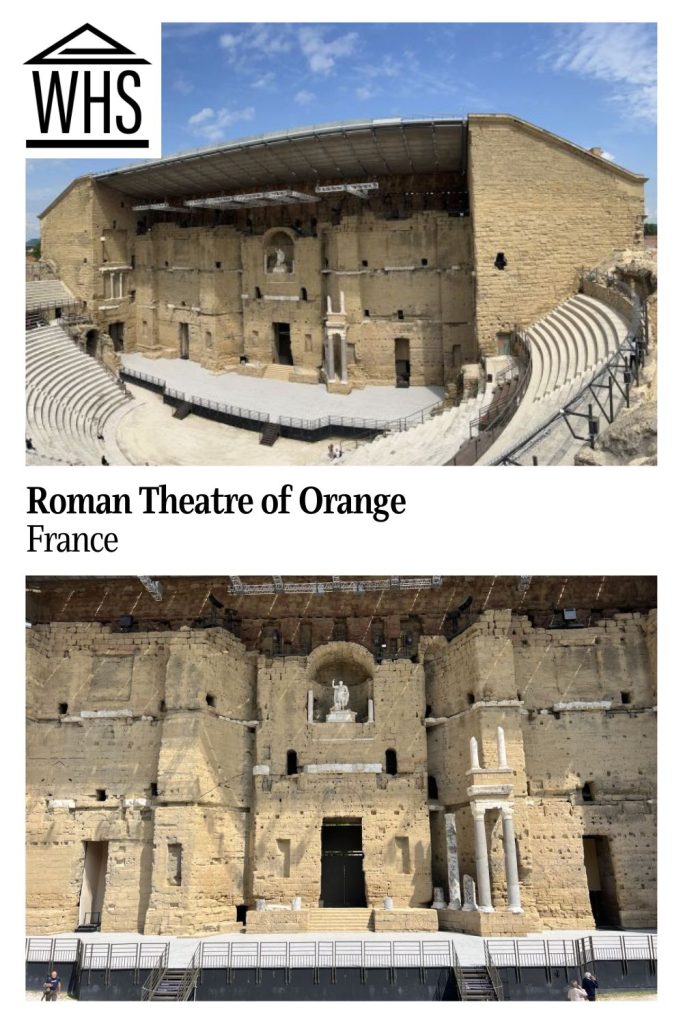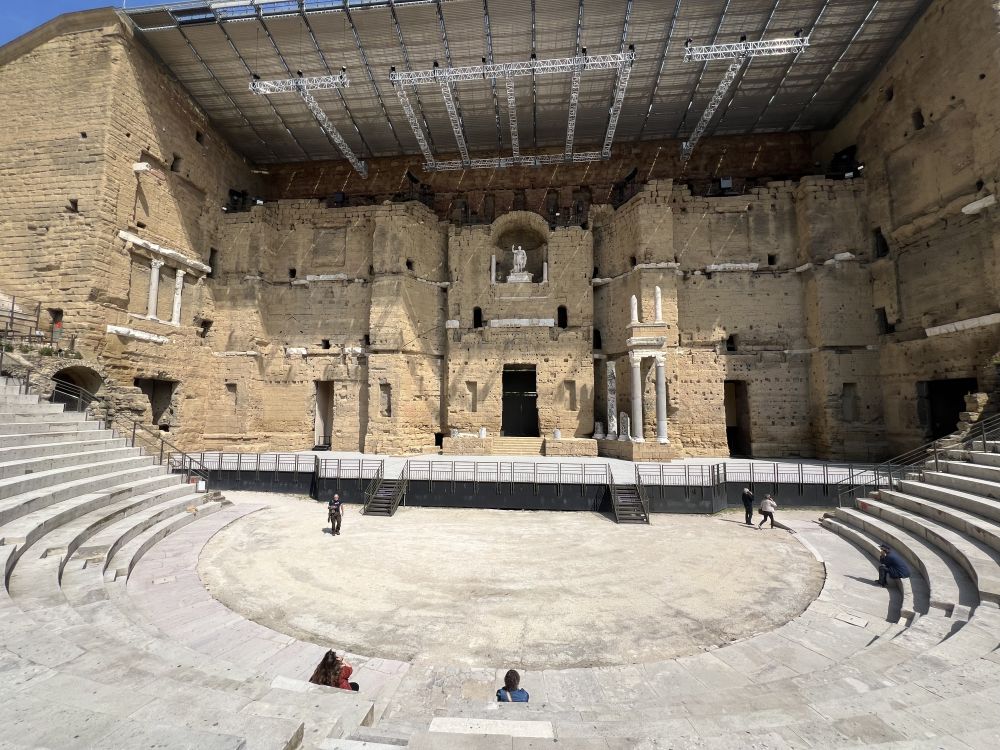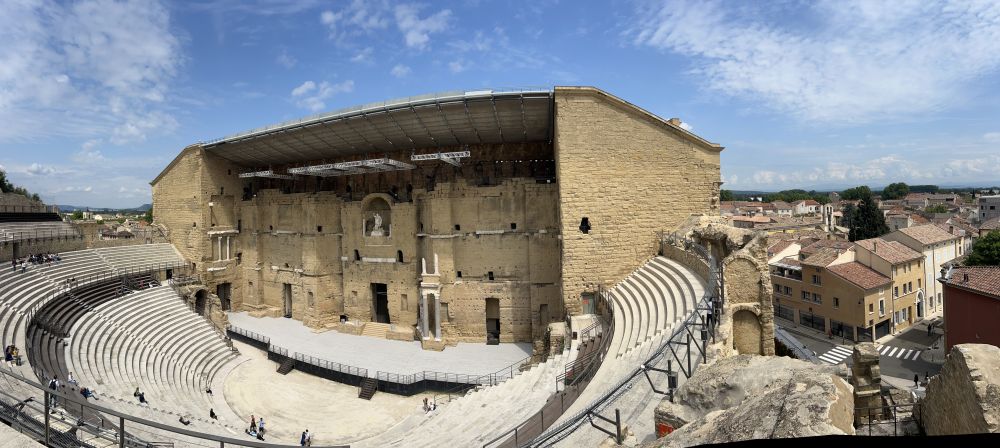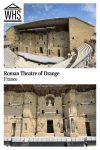Roman Theatre and its Surroundings and the “Triumphal Arch” of Orange
By Ersilia Octave
What is the Roman Theatre of Orange?
The Théâtre Antique d’Orange is one of the best-preserved Roman theatres in the world and a UNESCO World Heritage Site since 1981. Located in a small town called Orange, in Provence, this monumental structure dates back to the early 1st century AD and was once the beating heart of Roman entertainment in the region.
The first time I walked through its massive stone archways, I was honestly not expecting it to be that big: it’s huge. I had only ever visited the Colosseum in Rome, and I thought nothing could top that, but Orange’s theatre is breathtaking in its own way.
Its 37-meters-high and 103-meter-long stage wall (121 x 338 feet) towers over you, still almost completely intact, making it one of the rare Roman theatres in the world to have kept its original backdrop.

Disclosure: This article contains affiliate links. Making a purchase through an affiliate link will mean a small commission for this website. This will not affect your price. Privacy policy.
What makes it special? I thought I’d find a ruin, but this is almost an intact building. You can climb to the top tiers, admire views of the surrounding town and Provençal hills, and actually feel how extraordinary the acoustics still are. It’s a living monument, too: operas and concerts are still held here every summer, bringing the space back to life just as it was 2,000 years ago.
Why are the Roman Theatre and the Triumphal Arch in Orange a UNESCO World Heritage Site?
The theatre earned its UNESCO status because of how remarkably well it represents Roman architecture and cultural life. Built under Emperor Augustus, it was designed for entertainment but also as a symbol of Roman power and civilization in Gaul.
While many Roman theatres lost their stage walls over time, Orange’s has survived almost untouched, giving us an authentic glimpse into what a Roman performance space really looked like.

As for the Triumphal Arch nearby, UNESCO calls it “one of the most beautiful and interesting surviving examples of a provincial triumphal arch from the reign of Augustus.” It is also important for the low reliefs on its north side, which portray the “war against the Barbarians and establishment of the Pax Romana.”
What can you expect on a visit to the Théâtre Antique d’Orange?
Visiting the theatre feels like stepping back in time when the Romans ruled here. The audioguide (highly recommended) takes you slowly through the different tiers and explains not only the history but also how the theatre was used: from comedies and tragedies to political speeches. There are around 24 stops, each giving you a new perspective and helping you appreciate the theatre from every angle.
The climb to the top seating area is worth every step, not just for the sweeping views, but also because you’ll find small exhibition rooms up there explaining Roman construction techniques and daily life.
If you’re traveling with kids (or you’re just a curious adult like me), try the optional VR headset experience at the entrance (€5). It’s a fun, short 3D film that reimagines the theatre in its years of glory, complete with a story about a young girl traveling back to Roman times. Several painting workshops are organised for the younger ones; check the timetables for more information.
For something even more immersive, consider booking a theatrical visit, where actors dressed as ancient Romans or Roman goddesses guide you through the theatre and bring its history to life in a fun, interactive way.
And if you can stay until evening, don’t miss L’Odyssée Sonore. This nighttime sound-and-light experience transforms the theatre into a mythological stage, complete with glowing projections and 3D sound. Guided by the voice of Terra, the Earth goddess, you’re drawn into a story where gods and humans must reunite to restore harmony. It’s part performance, part dream, and an unforgettable way to see the theatre in a completely different atmosphere.

Is the Roman Theatre of Orange worth visiting?
Absolutely! Even if you’re not a hardcore history lover, the sheer scale and preservation of this theatre will blow you away. It’s one of those rare sites that makes you feel connected to the people who once sat here cheering, laughing, or gasping at a performance two millennia ago.
If you’re touring Roman sites in Provence, pair it with Glanum or the Pont du Gard (also a UNESCO site) for a full Roman-history day. But honestly, the theatre alone is worth a special trip to Orange. Arles is another UNESCO site not too far away that includes both Roman and Romanesque elements.
Who would love the Théâtre Antique d’Orange?
Anyone with an interest in Roman history or architecture will be thrilled. Families will appreciate the kid-friendly VR experience. For concert lovers, this is the place to watch a performance in Provence — the acoustics are phenomenal.

Tips for visiting the Roman Theatre of Orange
The best time to visit is late afternoon for the best light and fewer crowds.
Order your tickets ahead of time. The ticket also gives you access at the History and Art Museum across the road. The VR headset costs an additional €5. You need separate tickets for L’Odyssée Sonore.
Make sure to bring a hat, water and good shoes. The theatre involves some stair climbing, so wear comfortable shoes, but it’s generally accessible for most visitors.
A tip: If you’re visiting in June or July, try to book tickets for the Chorégies d’Orange, the famous opera festival held inside the theatre.
Where is the Roman Theatre of Orange?
The theatre is right in the center of Orange, about 40 minutes north of Avignon by car or 15 minutes by TER train. The Triumphal Arch is about a 15-minute walk away from the theatre on the Avenue de l’Arc de Triomphe.
Parking is available nearby, and the town itself is charming enough to make a half-day or full-day stop. Combine your visit with a stroll through Orange’s historic streets or a wine tasting in the surrounding Côtes du Rhône vineyards.
Book accommodations in Orange.
Many travelers base themselves in Avignon, making Orange an easy half-day trip.
Book accommodations in Avignon.
If you’re on a longer Provence itinerary, you could combine it with a stop in St-Rémy-de-Provence, about an hour and 15 minutes away, for a completely different vibe.
For more details on admission fees and opening times, you can check the official website of the Théâtre Antique d’Orange.
Have you been to Orange and seen the theatre or the triumphal arch? If so, do you have any additional information or advice about this UNESCO World Heritage site? Please add your comments below!


